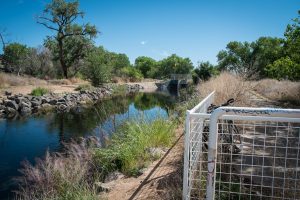
Albuquerque wastewater treatment plant outfall
My University of New Mexico Water Resources Program colleague Bruce Thomson loves to point out that Albuquerque’s wastewater treatment plant is, in New Mexico, the second largest tributary to the Rio Grande after the Rio Chama. But as tributaries go, it’s a short one – under 100 yards/meters from the outfall to the main river channel. I’ve long harbored a not-so-secret dream/scheme – what if, rather than a short rock-lined channel, we could route that water through the nearby riverside woods, getting an increased benefit in riparian vegetation and habitat along the way?
Tony Davis in the Arizona Daily Star reports that Tucson is considering just that:
The long-dead Santa Cruz River could flow again within two years.
Tucson Water, which had opposed the idea for years, unveiled a blueprint last week for putting heavily treated wastewater in the river through downtown Tucson. Officials call the plan “Agua Dulce,” Spanish for sweet water.
The idea would be to pump the effluent uphill from a sewage treatment plant northwest of the city via an existing pipeline south to 29th Street. From there, effluent would run downhill through the city’s core; the Santa Cruz flows south to north. Officials don’t know yet know how far downstream the water would run.
There are big differences, but the underlying principle is similar – leverage wastewater for environmental benefit. Lots of hurdles in both cases. In Albuquerque, the most important one would be the water losses – the riparian vegetation my scheme would consume water.

Yes, the vegetation will consume a good bit of water…also will also slow and purify it and support bird and wildlife habitation, and provide a mini-ecosystem of humidified air, oxygen rich I am sure. Sounds like it would be “more natural”, a benefit in this day and time.
Pingback: Blog: Effluent as an environmental good | H2minusO Blog
The general idea sounds cool but be careful about the vegetation “purifying” the wastewater. Unless the wastewater treatment includes reverse osmosis (salt removal) it will typically be relatively high in salts to begin with. The vegetation will then tend to evapotranspirate a large fraction of the pure water in the wastewater leaving the rest (run-off/percolate) with even higher salt concentration, by a factor of 400%, or more. As long as what is downstream/downgradient can handle that, its OK….but far from purified. Of course all this must be compared to what it otherwise happening to the water/salts to see if mitigation would be required/desireable.